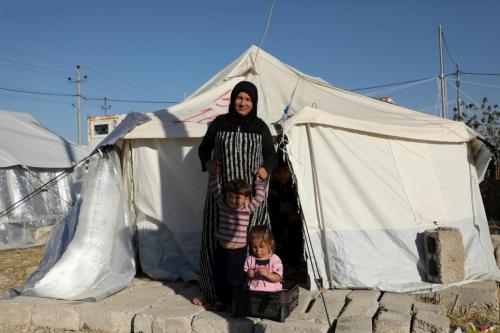Winter preparations for Syrian refugees and displaced in full swing
This is a summary of what was said by UNHCR spokesperson Babar Baloch – to whom quoted text may be attributed – at today's press briefing at the Palais des Nations in Geneva.
UNHCR, the UN Refugee Agency, estimates that some 3.8 million Syrian and Iraqi refugees, as well as internally displaced people and refugees of other nationalities, are in need of additional assistance this winter in Syria, Iraq, Lebanon, Jordan and Egypt. For many of the Syrians, this is the ninth consecutive winter they will spend in displacement. Ongoing preparations for assistance began in September and support will continue throughout winter until March next year.

Syrian refugee Nadira stands in the sunshine outside her family tent in Bardarash camp, Dohuk governorate with her three-year-old son and four-year-old daughter. Their flight from Syria was a struggle and now Nadira fears the coming winter.
Preparations include deliveries of core winter relief items such as high-thermal blankets, plastic sheets and warm clothing. Refugee shelters are being repaired and improved to make them weather-proof. Other activities include improvements to drainage systems and other infrastructure, both in camps and informal settlements. Vulnerable refugee families are being provided with seasonal cash assistance to meet their additional needs during the cold winter months.
Given the drop in temperature and rains across the region, UNHCR teams and our partners are already distributing winter assistance in Syria and Iraq. As of the end of October, more than 364,000 refugees and internally displaced people (IDPs) have been reached with winterization assistance in these two countries. In Lebanon, Jordan and Egypt, identification of beneficiaries for winterization assistance is ongoing.
Across Syria, UNHCR aims to reach 1.6 million Syrian IDPs (320,000 families). Assistance is prioritized for vulnerable IDPs and returnees, newly displaced families, people living in hard-to-reach areas and in sub-standard shelters, spontaneous returnees, as well as people in newly accessible locations who have not been assisted in the past. Distributions so far include north-east Syria, where UNHCR, as part of the inter-agency efforts, has provided basic aid and winter items to more than 177,500 newly displaced people in host communities, collective shelters and camps, including to over 86,500 people in in Al-Hol, Areesha, Roj and Mahmoudli camps.
UNHCR in Iraq aims to deliver winter assistance to over 660,000 IDPs (110,000 families) - 157,700 Syrian refugees (38,300 families), and 16,800 refugees of other nationalities (4,200 families). During October alone, more than 89,000 IDPs and returnees (nearly 15,000 families) received winter cash assistance. Nearly one in three of these families was headed by a woman.
In Lebanon, UNHCR is providing winter aid to more than 860,000 Syrian refugees (some 172,000 families) and 9,000 Iraqi refugees (3,000 families) living below the poverty line. 73% of the Syrian refugee families in Lebanon live below the poverty line which is USD 3.84 per capita a day. They are unable to cover their basic survival needs such as food, health and shelter. As a consequence, there are increased protection risks and exposure to negative coping mechanisms such as child labour, early marriages or survival sex. Almost nine out of ten households are indebted, clearly indicating that Syrian refugee families lack the resources to cover their essential needs. During winter, their situation is exacerbated by economic shocks associated with harsh weather conditions and the reduction of already limited income opportunities. In addition, many families will face additional health risks as they cannot keep warm. There are floods and access to health care is already limited. In light of the major economic crisis currently affecting Lebanon, UNHCR’s winter campaign this year will reach more vulnerable Lebanese families than in previous years to ensure that they can stay warm during the winter season despite their rapidly deteriorating situation.
Starting this month, in Jordan UNHCR is reaching more than 310,000 Syrian refugees (69,000 families) in camps and urban areas this winter season. In two large camps - Azraq and Zaatari - families will be supported with a one-time winter cash assistance through the common humanitarian cash distribution facilities and will receive cash to obtain gas for heating. In urban areas, UNHCR will also provide a one-time package that covers the cost of a heater, a gas canister, gas refills for four months and blankets for each family member.
In Egypt, UNHCR plans to provide seasonal cash assistance to more than 87,000 Syrian refugees (29,000 families) and 3,934 Iraqi refugees (1,659 families), starting in November.
UNHCR is grateful for the support our government and private sector donors have shown so far for our efforts to aid and protect Syrian refugee and IDPs. However, the overall funding of UNHCR operations for IDPs in Syria and Syrian refugees in neighbouring countries in 2019 stands at 43 per cent of required USD2.180 billion.
Syrians remain the largest refugee population in the world. More than 5.6 million live in neighbouring countries and across North Africa. Another 6.2 million are estimated to be displaced within Syria.
Source: United Nations High Commissioner for Refugees
- 197 reads
Human Rights
Ringing FOWPAL’s Peace Bell for the World:Nobel Peace Prize Laureates’ Visions and Actions

Protecting the World’s Cultural Diversity for a Sustainable Future

The Peace Bell Resonates at the 27th Eurasian Economic Summit

Declaration of World Day of the Power of Hope Endorsed by People in 158 Nations

Puppet Show I International Friendship Day 2020

